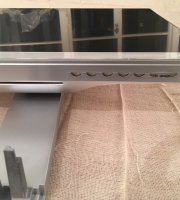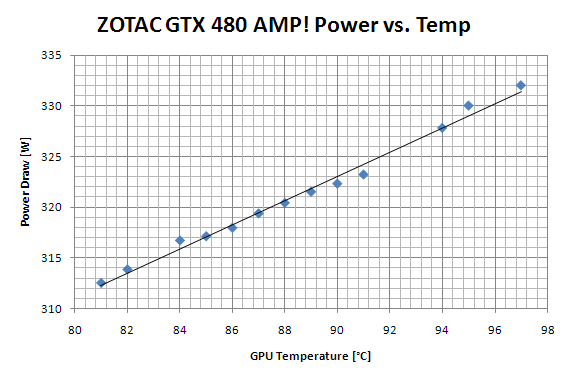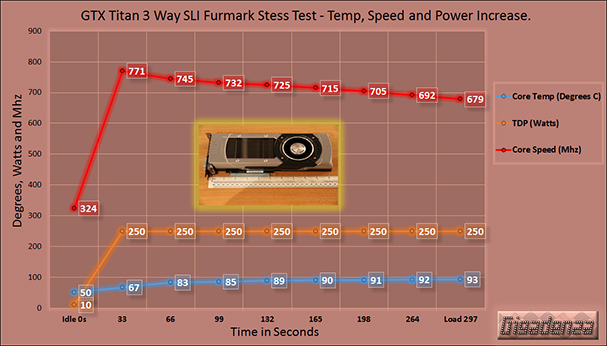


Let’s briefly examine why. Ha! why sure. Just as I insisted things would be simple a veritable eternity ago. Here is a graph depicting the result of a revealing experiment conducted by TechPowerup.com, very likely the internet’s most productive source of studies exploring the temperament, psyche and genetics of the modern GPU.

By convenient coincidence, the experiment’s subject was famously voracious for voltage and will provide us with a best case scenario to avail the ecstasies of exotic cooling. The feriy fermi in flagship form under capable care of Zotac. Their traditional “amplified” remix appeared dapper, decked out with a stylish black shroud whose twin topaz fans wove whirls of amber abundance, and despite boosted speeds out of the box, the most aggressive of any rival’s reversion, consumed an average of 25 watts less than pain old vanilla.
The test measured the card’s power draw as it increased from 312 to 332 watts, a range of 20 watts and offset the values against its core temperature, which rose from of 80 degrees to 98, a window of 18 degrees. Readings were taken with an ornate appliance it would take me longer to turn on than for you to have read this far, and concluded that under full load, every additional degree incurred a 1.2W penalty.

Here, in a second graph, is a less scientifically secure illustration of our initial test. As you’ll recall, the Titan was inhibited by its electrical allowance whilst its temperature tip toed two degrees inside the GPU’s absolute limit, demonstrating that even the humble stock cooler was equipped to prevent the card’s heat precautions from taking precedence over its battle to preserve power.
Its Idle temperature was 50 degrees, which climbed to 93 degrees under load, a window of 43 degrees. However, to make our imminent calculations commensurate with those above, we need only concentrate on the 15 degree increase from 78 to 93 degrees.
Prior to the benchmark beginning, afterburner shows power consumption to be non-existent, which of course is impossible, so let’s agree to settle on 10 watts or 4% as per various reviews. At load it reached its limit of 250W or 100%, an operating range of 246W or 96%. Again, to align our equations with those of Tech Powerup we only consider the concluding 20 watt rise.
Summary:
Zotac GTX 480 AMP – 312-332 watts
Vanilla GTX Titan – 228-250 watts
Zotac GTX 480 AMP – 81-97 degrees
Vanilla GTX Titan – 78-93 degrees
It is here we encounter a hitch. Afterburner’s power meter is a flat line, implying the card’s TDP was exceeded the moment Furmark commenced and variance thereafter was negligible. Unfortunately, I am bereft of the apparatus to accurately verify voltage, so the sake of argument, let’s pretend the both card’s power and thermal readings ascend at a fixed angle over the same 15 degree and 20 watt ranges – they wouldn’t, but my weariness permits such a leap of faith.
The Titan’s power envelop is 250W compared to the the Zotac’s “self-determined” 332w, a difference of 82 watts, or 25%, hence, let’s also assume the card is a quarter thriftier with its resources and divide 1.2 watts (the value per degree for the Zoltac) by 4, then multiply by 3 giving us estimated comparison of 0.9 watts per degree. Finally, we’ll multiply 0.9W by our temperature window of 15 degrees and we have a total ascent of 13.5 watts in contrast to the 480s 18 over the same thermal range.